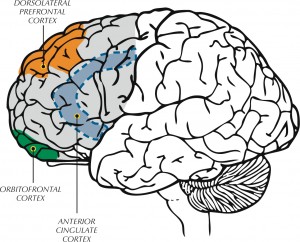
Executive Function: A Key in Child Development
What is executive function?
Executive Function (EF) is the ability to connect, regulate and organize the different functional regions of the brain, such as behavioral control, risk/reward decision, reactions and responses, etc. Namely, in terms of problem solving, EF involves the ability to size up a problem, come up with a plan for solving the problem, and modify the plan when necessary changes are needed (Havasy).
Generally, EF is considered to be divided into three components: inhibition (or inhibitory/self control), working memory, and mental flexibility (or shifting).
Inhibition is the ability to resist thinking or doing things that are tempting, but to control oneself focusing on the things that are proper or important. For example, if you have a test tomorrow you will inhibit your desire to hang out with friends in order to study. This decision is a paradigm example of the first component of EF.
Working memory is the ability of keeping information in mind where it can be manipulated. This ability or skill plays a key role in performing cognitive tasks such as leaving home for school. For example, getting dressed, having breakfast, packing your school bag, and taking the shuttle are a sequence of movements that is stored in the working memory.
Mental flexibility is the ability to switch from one task/mental state to another. The idea of such shifting entails the ability to adjust what to do next according to the change of the request.
What does it have to do with kids?

The executive functions are associated with the prefrontal cortex of the frontal lobe, which is a part of the brain known to play a role in decision making. Brain development takes time. The maturation of the prefrontal cortex in particular could take many years (from infant to adulthood). During this period of time, the EF gradually develops as the prefrontal cortex matures. If the child is not properly raised and educated, serious problems could occur from childhood into adulthood when one enters society as a more independent individual.
Executive Function Issues
What are possible issues that could come from a lack of proper development of executive functions?
- Difficulty in paying attention and can be easily distracted
- Not able to multitask
- Difficulty in making plans
- Has trouble figuring out how much time a task requires
- Difficulty in solving problems using previous knowledge
All of these issues can lead to huge obstacles in one’s daily life. Over time, the number of problems may increase. Children with poor EF could be struggling in many aspects of their lives such as academic achievement and social interaction.
What causes these problems?
Generally speaking, there are three major reasons why children or adults might have executive function issues. The problem may be genetic (innate or inborn), caused by a brain injury, or be the result of one’s early childhood experiences.
Other problems related to Executive Functions
Usually, poor executive function is comorbid with other disorders since the symptoms between them can be quite similar. For example, attention-deficit hyperactivity disorder, which is widely known as ADHD, is one of the most common childhood brain-based disorder that exists simultaneously with EF issues. In the video below, Dr. Barkley explains how these may be interrelated. Due to the similar symptoms, however, it is possible that an executive function issue can be misdiagnosed as ADHD (Morin).
How to help children develop better executive function
Early intervention can have a significant influence in a child’s brain development, including the prefrontal cortex. Such intervention includes a system of services that focuses on helping babies and toddlers learn the basic and new skills that are typically developed during those early years of life.
For example, during a parent-child intervention, the caregiver can encourage an increase in the quality of interaction (sensitive responsiveness), creating security of attachment, and learning to collaborate well with the child. Developing better parent-child relationship can be a protective factor for children who may be exposed to the negative effects of stressful circumstances such poverty.
